10 years of war: A timeline of Russia's decade-long aggression against Ukraine
- Oops!Something went wrong.Please try again later.
Almost immediately following the end of the EuroMaidan Revolution in Ukraine in February 2014, Russia swiftly moved to annex and occupy the Crimean Peninsula. Within a couple of months, unrest erupted in eastern Ukraine followed by Russian-backed militias taking over administrative buildings.
The events mark the start of Russia's 10-year invasion and occupation of Ukraine that continues to this day.
The Kyiv Independent has compiled a timeline covering the major events over the last 10 years of Russia’s war against Ukraine.
Feb. 20, 2014:
The annexation of Crimea
Throughout February 2014, Russia began quietly increasing its presence at its Black Sea Fleet base in Sevastopol in Crimea. Toward the end of the month on Feb. 20, 2014, armed men without insignia moved to block off airports in Sevastopol and Simferopol and Ukrainian military bases on the peninsula and seized the Crimean Parliament building. The annexation effectively began Russia's ongoing war against Ukraine. Russia has occupied Crimea in the following days.
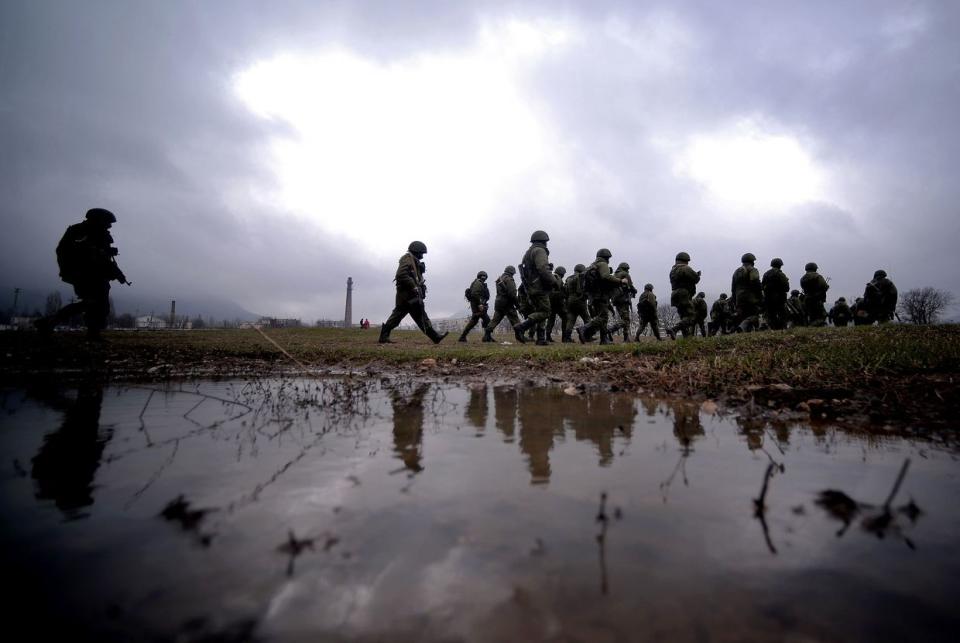
Russian soldiers patrol the area surrounding the Ukrainian military unit in Perevalnoye, outside Simferopol, Crimea, on March 20, 2014. (Filippo Monteforte/AFP via Getty Images)
Read more: Russia’s annexation of Crimea
April 12, 2014:
Invasion of Donbas begins
Russia-backed militants led by former Federal Security Service (FSB) officer Igor Girkin (Strelkov) forcibly took control of Interior Ministry offices in Sloviansk and Kramatorsk in Donetsk Oblast, kicking off the invasion of the eastern region.

Russian-led separatists occupy the governor´s office in Luhansk and lower the Ukrainian flag on April 29, 2014. (Alex Inoy/Anadolu Agency/Getty Images)
April 13, 2014:
Ukraine launches
Anti-Terrorist Operation
Oleksandr Turchynov, Ukraine's acting president following the EuroMaidan Revolution, announced the “Anti-Terrorist Operation” (ATO) in Donetsk and Luhansk oblasts in response to the invasion of Ukraine’s eastern Donbas region by Russian-backed proxies. It was later renamed the Joint Forces Operation.

Interim president of Ukraine, Olexandr Turchynov, attends a meeting with German Foreign Minister Frank-Walter Steinmeier (not pictured) in Kyiv, Ukraine on May 13, 2014. (Thomas Koehler/Photothek via Getty Images)
June–July, 2014:
Liberation of eastern cities
Over the summer of 2014, Ukrainian forces began to regain territories occupied by Russian-backed forces. Ukrainian forces regained full control of Mariupol on June 13, 2014, and liberated a number of cities in Donetsk and Luhansk oblasts, including Kramatorsk, Sloviansk, Sievierodonetsk, and Lysychansk in July 2014.

Demonstrators hold Ukrainian flag during a rally in the southern Ukrainian city of Mariupol to call for peace and for a unified Ukraine on July 13, 2014. (Soner Kilinc/Anadolu Agency/Getty Images)
August 2014:
Battle of Ilovaisk
After almost a month of fierce fighting that began on Aug. 6, 2014 and lasted until Aug. 31, columns of Ukrainian soldiers who had been promised safe passage by Russian-backed proxies through a pre-agreed corridor out of the city were fired upon by heavy artillery. In total, 368 Ukrainian soldiers were killed in what is now known as the Ilovaisk massacre. More than 400 were wounded, and around 300 were captured. This was the biggest instant loss of the Ukrainian Armed Forces up until that point.

A Ukrainian serviceman looks at images of dead comrades as he attends a memorial ceremony on Aug. 29, 2015 in Kyiv marking the first anniverary of the Battle of Ilovaisk near Donetsk. (Sergei Supinsky/AFP via Getty Images)
July 17, 2014:
Downing of the MH17
On July 17, 2014, Malaysia Airlines Flight MH17 was shot down over eastern Ukraine as it was traveling from Amsterdam to Kuala Lumpur. All 298 people on board, including 80 children, were killed. After an international investigation, a Dutch court in 2022 convicted two Russians, Igor Girkin and Sergey Dubinsky, and Ukrainian Leonid Kharchenko fighting on the Russian side with the downing of the airliner with a Moscow-provided Buk anti-air missile system. Russia continues to deny its involvement and blames Ukraine, spreading fakes about the circumstances and causes of the tragedy.

Debris from Malaysia Airlines Flight 17 is shown smoldering in a field on July 17, 2014 in Grabovo, Ukraine near the Russian border. (Pierre Crom/Getty Images)
Sept. 5, 2014:
Minsk Protocol
Ukraine, Russia, and the Organization for Security and Co-operation in Europe (OSCE) signed the Minsk Protocol in the capital of Belarus — the first peace plan to try to stop the war. It failed, as Russian troops almost immediately breached the ceasefire.

From left: Former Ukrainian president Leonid Kuchma, representative of Russian proxies in Donetsk Oblast Alexander Zakharchenko, OSCE envoy Heidi Tagliavini, Russian Ambassador to Ukraine Mikhail Zurabov, and Russian proxy leader in Luhansk Oblast Igor Plotnitsky make an official statement on the signing of a ceasefire agreement in Minsk, on Sept. 5, 2014. (Vasily Maximov/AFP via Getty Images)
Jan. 21, 2015
Russian backed-forces
capture Donetsk Airport
The battle for Donetsk airport, one of the longest and bloodiest in the war, ended after 242 days of standoffs with Russian-backed troops, who far outnumbered Ukraine's forces. After enduring months of intense combat, the remaining Ukrainian soldiers on Jan. 21, 2015 left their positions in the air terminals, which had been nearly destroyed. The battle for the airport, whose defenders are widely known as “cyborgs,” has become a symbol of resistance.

View of the Serhii Prokofiev International Airport in Donetsk taken on Oct. 9, 2014, after weeks of shelling between Ukrainian army forces holed up inside and Russian-backed troops. (John Macdougall/AFP via Getty Images)
Feb. 12, 2015
Minsk II
A revised version of the Minsk Protocol, dubbed Minsk II, was signed following a successful Russian military campaign in February 2015 and huge losses on the Ukrainian side in the Battle of Debaltseve. The agreement did little to change the situation, with both sides fundamentally disagreeing on interpretations of the text. It was highly criticized for being convoluted and too similar to Minsk I.

From left: Belarussian President Alexander Lukashenko, Russian President Vladimir Putin, German Chancellor Angela Merkel, French President Francois Hollande and Ukrainian President Petro Poroshenko pose for a photo during a summit in Minsk, Belarus on Feb. 11, 2015. (Sasha Mordovets/Getty Images)
Nov. 25, 2018
Kerch Strait incident
Russian ships opened fire at three Ukrainian Navy boats as they tried to cross the Kerch Strait on their way to the Ukrainian port of Mariupol in the Azov Sea. It was the first time that Russia attacked Ukraine openly, under its own flag, without hiding behind its proxies. Moscow claimed that the vessels had “violated the prohibited area” despite the fact that the sea was commonly used by both countries. After the attack, Russia seized the Berdiansk and Nikopol military ships and the Yany Kapu tug and captured 24 Ukrainian sailors, six of whom were wounded. President Petro Poroshenko introduced martial law in 10 of Ukraine’s oblasts for 30 days in response.

Ukrainian President Petro Poroshenko during a parliamentary session in Kyiv, Ukraine on Nov. 26, 2018. (Danil Shamkin/NurPhoto via Getty Images)
Sept. 7, 2019:
First major prisoner exchange
A plane with 35 Ukrainians released from Russian captivity landed at Kyiv’s Boryspil International Airport on Sept. 7, 2019. The long-awaited exchange was the first mass prisoner swap since the beginning of Russia’s war in Donbas. It brought home film director Oleh Sentsov and 24 Ukrainian sailors among others.

From left: commander of the 1st division of the ships of the guard of the raid of the naval command, captain of the second rank, Denys Hrytsenko, senior commander of the small armored artillery boat "Berdiansk" Andriy Artemenko and sailor, electrician of the small armored artillery boat "Nikopol" Andriy Oprysko, released during a large prisoner swap between Russia and Ukraine, attend a joint press conference in Kyiv, Ukraine, on Sept. 12, 2019. (STR/NurPhoto via Getty Images)
Dec. 9, 2019:
Normandy Four meeting
The leaders of Ukraine, France, Germany, and Russia met in Paris on Dec. 9, 2019 as part of the Normandy Four meetings. The talks only resulted in a joint statement signed by the leaders of the countries present confirming that the Minsk agreements signed in February 2015 would form the basis of the peace process. It was the first and last time Ukraine’s President Volodymyr Zelensky and Russian President Vladimir Putin met in person.

From left: Ukrainian President Volodymyr Zelensky, French President Emmanuel Macron, Russian President Vladimir Putin and German Chancellor Angela Merkel attend their summit on Ukraine at the Elysee Palace in Paris, France on Dec. 9, 2019. (Christophe Petit Tesson - Pool/Getty Images)
April 2021:
Russia moves more troops
to Ukraine’s borders
In April 2021, Russia began amassing a large number of its troops on the border with eastern Ukraine and in Crimea. A few months later, foreign media reported that the troop buildup had expanded, followed by numerous publications suggesting that Moscow might be preparing for a broader invasion of Ukraine. Many Ukrainian officials said they saw no signs of a threat and that the situation was “under control,” downplaying NATO countries’ warnings about the possible upcoming invasion and, closer to the end of the year, its detailed scenarios reported by Western journalists. The Ukrainian military said it was ready to fight back if necessary. As of mid-February 2022, Russia had amassed up to 190,000 troops on the border with Ukraine.

A member of the Ukrainian State Border Guard stands watch at the border crossing between Ukraine and Belarus in Vilcha, Ukraine on Feb. 13, 2022. (Chris McGrath/Getty Images)
Feb. 21, 2022:
Putin declares 'independence'
of the territories occupied
since 2014
Three days before the launch of the full-scale invasion Russian President Vladimir Putin on Feb. 21, 2022 announced Russia was recognizing the entire Donbas region in eastern Ukraine as belonging to illegitimate “independent states."

Screenshot from video of the address by Vladimir Putin (with English captions), which announced the beginning of the Russian invasion of Ukraine. (Wikimedia)
Feb. 24, 2022:
Russia launches full-scale
invasion of Ukraine
At 3:40 a.m. on Feb. 24, 2022, the first column of tanks entered the territory of Luhansk Oblast. A few minutes later, the Kremlin published an address by Russian President Vladimir Putin in which he launched what he euphemistically called "a special military operation" against Ukraine, de facto declaring war on the country. Soon after, explosions occurred in several cities across Ukraine. Russia launched air strikes on dozens of targets across Ukraine as its troops launched a ground offensive from Russia, Belarus, and the occupied territories of Donetsk and Luhansk oblasts, moving deeper into the country.

Inhabitants of Kyiv leave the city following the first missile strikes of the Russian armed forces on Feb. 24, 2022 in Kyiv, Ukraine. (Pierre Crom/Getty Images)
March 16, 2022:
Mariupol drama theater
air strike
A Russian warplane on March 16, 2022 dropped a bomb on a drama theater in besieged Mariupol, Donetsk Oblast where about 1,000 people had been taking shelter. The theater had the word “children” written on the ground in front of it to indicate that there were children sheltering there. The data on the number of deaths vary. An investigation by the Associated Press showed that Russia’s air strike could have killed 600 residents.
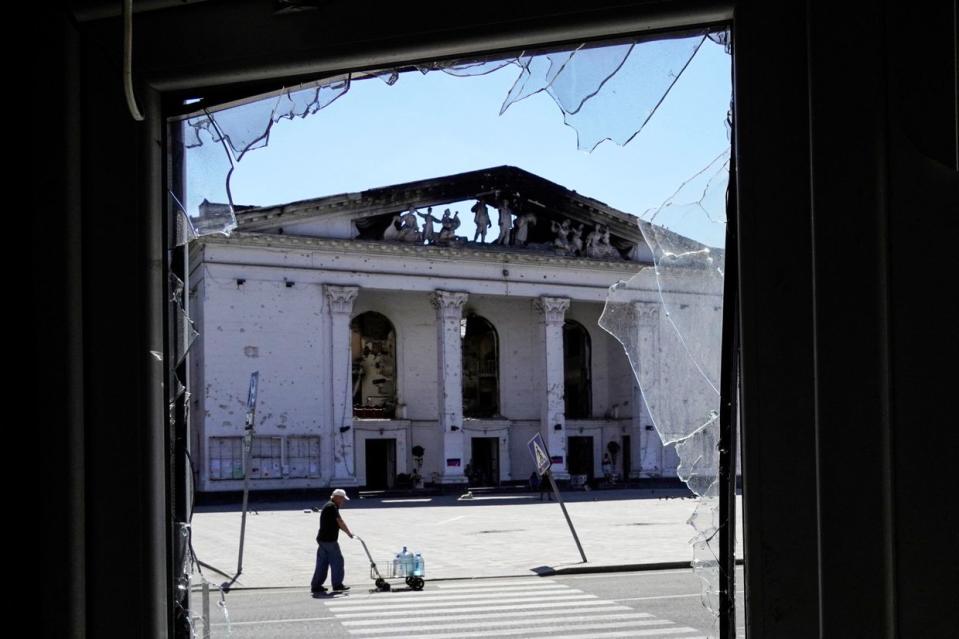
A man carries bottles with drinking water past the partially destroyed Mariupol drama theater in the city of Mariupol on July 3, 2022. (Stringer/AFP via Getty Images)
April 2, 2022:
Liberation of Kyiv Oblast
After more than a month of heavy fighting, Russia's attempts to encircle Kyiv failed. Its troops retreated from the outskirts of the capital while Ukrainian flags were raised over Hostomel, Irpin, and other Kyiv suburbs. Ukraine’s victory was overshadowed by evidence of the horrific war crimes that the Russian army committed against civilians in the towns of Kyiv Oblast uncovered after liberation. Hundreds of residents of the Kyiv suburb of Bucha were found to have been tortured, raped, and executed.

Ukrainian President Volodymyr Zelensky (C) speaks to the press in the town of Bucha, northwest of the Ukrainian capital Kyiv, on April 4, 2022. (Ronaldo Schemidt/AFP via Getty Images)
Read more: Uncovering the scope of the Bucha massacre
April 14, 2022:
Sinking of the Moskva
The Russian flagship Moskva, the pride of its fleet, sunk in the Black Sea a day after Ukraine hit it with two domestically-produced Neptune anti-ship missiles. One of the most symbolic and expensive losses in the war, the sinking of the Moskva paved the way for the liberation of Snake Island, which helped to unblock shipping trade routes, and reduce threats of Russia’s attacks from the Black Sea, Ukraine's military intelligence said.

Reportedly the Moskva flagship on April 15, 2022, following a Ukrainian strike. (OSINTtechnical/X)
Read more: Historic loss of flagship deals humiliating blow to Russia's naval power
Read more: These are the most important Russian ships destroyed by Ukraine
May 20, 2022:
Surrender of Ukrainian troops
at the Azovstal steel plant
in Mariupol
Mariupol, a city in Donetsk Oblast with a pre-war population of about 500,000 people, came under siege at the end of February 2022, becoming synonymous with Russian crimes against Ukraine. After 86 days of defending the encircled city under heavy bombardment, about 2,500 Ukrainian fighters surrendered from the Azovstal steel plant – their last stronghold — after Ukrainian commanders ordered the defending garrison to lay down their arms. All of them were captured by Russia. According to authorities’ rough estimates, at least 25,000 people could have been killed during the siege of Mariupol. The exact number of dead remains unknown and could be much higher.
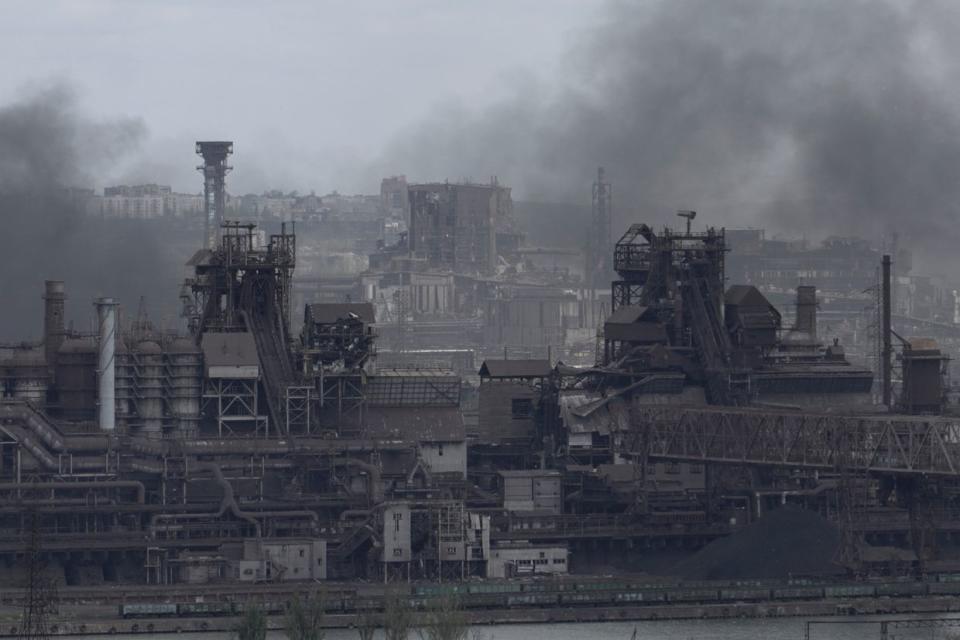
Smoke rises from the Azovstal steel plant in the city of Mariupol on May 10, 2022, amid the ongoing Russian military action in Ukraine. (Stringer/AFP via Getty Images)
Read also: Voices of besieged Mariupol: 'It’s not even comparable to hell'
June 30, 2022:
Recapture of Snake Island
Ukraine’s Armed Forces on June 30, 2022 recaptured Snake Island, located around 35 kilometers off the shore of Ukraine's southern Odesa Oblast. The one-square-kilometer island became infamous as the site where a Ukrainian soldier told the Russian Moskva warship to “go f*ck yourself” before surrendering to Russian forces on Feb. 24. Snake Island is considered strategically important, as it allows controlling the ground and, to some extent, the air space in southern Ukraine. After its liberation, Ukraine regained control of a part of the Black Sea.

A screenshot from a video posted by President Volodymyr Zelensky marking 500 days of full-scale war at Snake Island. (Volodymyr Zelensky / Facebook)
July 29, 2022:
Olenivka POW camp attack
An overnight explosion on July 29, 2022 at the Olenivka prison in occupied Donetsk Oblast killed 53 and injured over 100 Ukrainian prisoners of war, including Azov Regiment soldiers captured by Russia in Mariupol. Moscow accused Ukraine of attacking the prison with HIMARS, a high-precision rocket system, but presented no proof. Kyiv said that Russia killed Ukrainian prisoners of war to conceal evidence of torture. According to the Prosecutor General's Office, the blast was caused by a thermobaric munition.

Farewell ceremony for Ukrainian soldier Serhii Pavlichenko, who died as a result of an attack in a prison for prisoners of war in the town of Olenivka, Donetsk region in July 2022, in Kyiv, Ukraine on May 25, 2023. (Oleksii Chumachenko/Anadolu Agency via Getty Images)
Sept. 6, 2022:
Kharkiv counteroffensive
Ukraine’s Armed Forces launched an unexpected, lightning counteroffensive in Kharkiv Oblast on Sept. 6, 2022. Over the course of six days, Ukraine liberated almost all the occupied territories in the oblast from Russia, including Balakliya, Izium, and Kupiansk, a key logistics hub. Following the liberation of Kharkiv Oblast, Ukrainian investigators uncovered numerous cases of Russian war crimes, including torture chambers and a mass grave in Izium.

Workers at the scene of a mass grave in liberated Izium, Kharkiv Oblast on Sept. 19, 2022. (Kostyantyn Chernichkin/The Kyiv Independent)
Read more: With successful Kharkiv operation, Ukraine turns the war in its favor
Sept. 21, 2022:
Largest prisoner of war exchange
since the start of the
full-scale invasion
Ukraine and Russia on Sept. 21, 2022 conducted the biggest prisoner swap since the start of the full-scale war. A total of 215 defenders were released from captivity, including 108 Azov fighters, five Azovstal commanders, and 10 foreign fighters. Kyiv handed over 56 people to Moscow, including the high-profile pro-Kremlin Ukrainian politician Viktor Medvedchuk.

Azovstal defender, senior sergeant of the 36th brigade of the Ukrainian Armed Forces Mykhailo Dianov was released from Russian captivity under a prisoner exchange between Russia and Ukraine on Sept. 21, 2022. Left: Dianov at the Azovstal steel plant during the Russian siege of it. Right: Dianov after prisoner exchange on Sept. 21.(Azov/Operatyvnyi ZSU via Telegram)
Oct. 8, 2022:
Attacks on the Kerch Bridge
Early in the morning of Oct. 8, 2022, the Kerch Bridge, which connects mainland Russia with the Russian-occupied Crimean peninsula, was set ablaze after a powerful blast. The attack was the result of a special operation by the Security Service of Ukraine (SBU). The 19-kilometer bridge is a critical supply and transport route for Russian forces in Crimea and occupied Ukraine, and has been the target of repeated attacks. On July 17, 2023, it was hit by experimental Ukrainian "Sea Baby" marine drones. Both attacks collapsed sections of the road bridge.

Workers restore the railway tracks on the Kerch bridge that links Crimea to Russia, near Kerch, on Oct. 9, 2022, a day after it was damaged by a blast.(AFP via Getty Images)
Nov. 11, 2022:
Liberation of Kherson
Ukrainian troops entered Kherson on Nov. 11, 2022, the only regional capital that Russia had managed to capture since the start of the full-scale invasion. Locals took to the streets to celebrate liberation from Russian occupation wrapped in Ukrainian flags. During the extended counteroffensive launched in late August 2022, Ukrainian soldiers recaptured dozens of settlements on the west bank of the Kherson region.

Civilians carrying Ukrainian flags celebrate at Independence Square after the withdrawal of the Russian army from Kherson to the eastern bank of Dnieper River, Ukraine on Nov. 14, 2022. (Narciso Contreras/Anadolu Agency via Getty Images)
Read more: Kherson chronicle: From quick fall to liberation
Jan. 12, 2023:
Dnipro apartment strike
Russia struck a high-rise building in the city of Dnipro with a Kh-22 missile designed to destroy aircraft carriers. A total of 46 residents, including six children, were killed and over 80 were injured in one of the war's deadliest attacks.
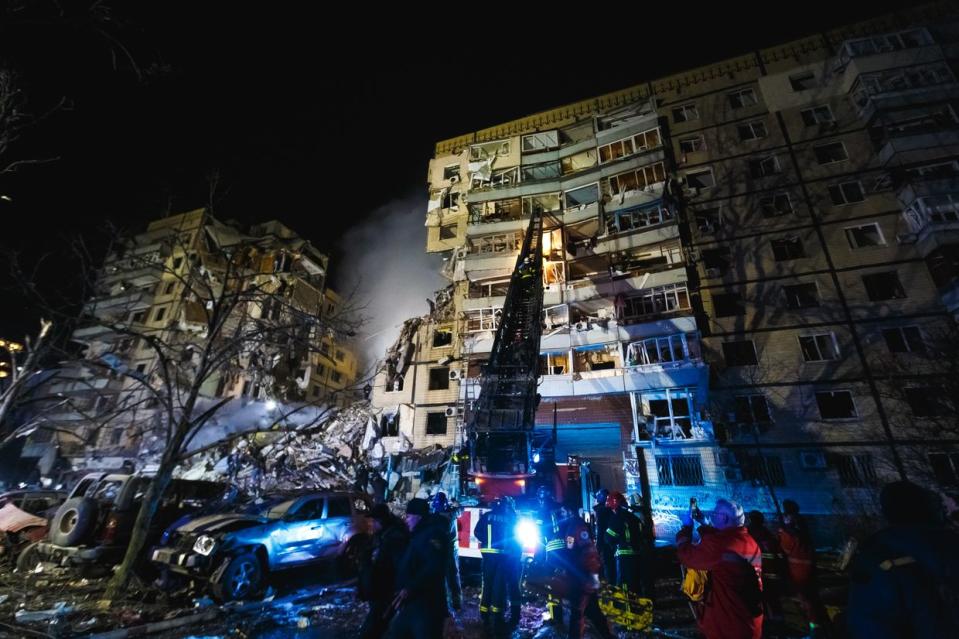
A rescuer climbs a ladder of a fire engine to one of the damaged apartments after a missile strike on Jan. 14, 2023 in Dnipro, Ukraine. (Yurii Stefanyak/Global Images Ukraine via Getty Images)
Read more: Russian missile attack on Dnipro destroys families as death toll rises
March 17, 2023:
ICC issues arrest warrant
for Russian President
Vladimir Putin
The International Criminal Court (ICC) issued arrest warrants for Russian President Vladimir Putin along with Russian Presidential Commissioner for Children's Rights Maria Lvova-Belova over their role in the deportation of Ukrainian children. Since February 2022, the Ukrainian government has identified over 19,500 children as having been abducted from Russian-occupied territories and sent to Russia, Belarus, or Russian-controlled areas of Ukraine. Only 388 of them have been able to return home so far.
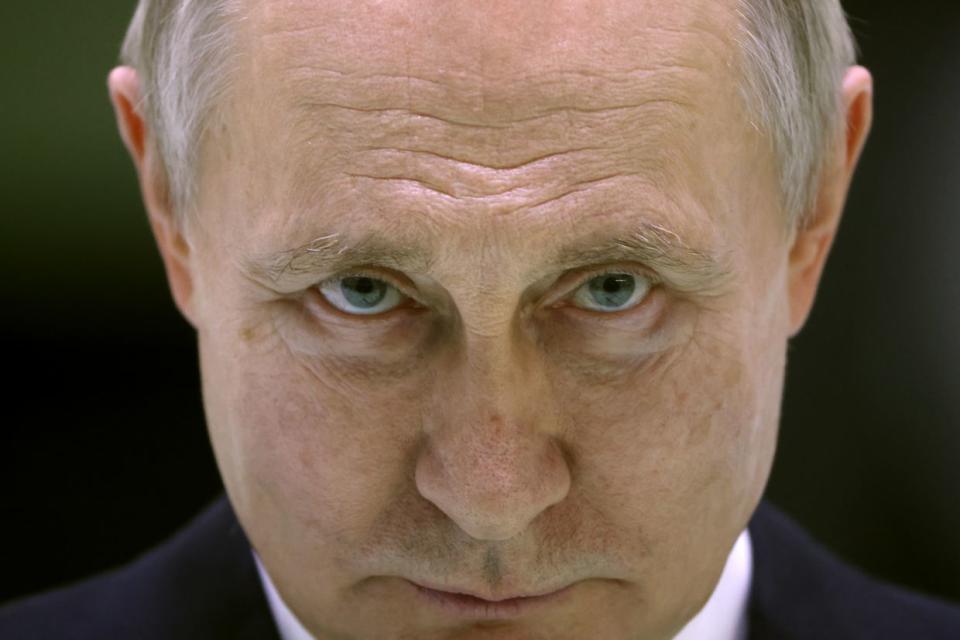
Russian President Vladimir Putin speaks as he meets with workers at the Obukhov State Plant in Saint Petersburg, Russia. Jan. 18, 2023. (Contributor/Getty Images)
May 20, 2023:
Bakhmut falls to Russia
Fierce fighting occurred in and around the city of Bakhmut in eastern Ukraine between August 2022 and May 20, 2023, when Russia officially took control of the area. It is considered to be the bloodiest battle of Russia’s full-scale invasion so far. Despite defeat in the battle, Ukraine said it had succeeded in inflicting major casualties on the Russian side. The U.S. estimated Russia's casualties in Bakhmut at 100,000 soldiers.

An aerial view of the city of Bakhmut totally destroyed from heavy battles on September 27, 2023 in Bakhmut, Ukraine. Destroyed towns in eastern Ukraine once again the focus of recovery efforts by Ukrainian forces. (Libkos/Getty Images)
Read more: Inside Ukraine’s costly mission to grind down Russia near Bakhmut
June 6, 2023:
Kakhovka dam destruction
In the early morning of June 6, 2023, an explosion occurred at the Kakhovka dam in the Russian-occupied part of Kherson Oblast, causing a humanitarian and environmental disaster across southern Ukraine. Russia was in control of the dam at the time and it is widely believed that Russian forces destroyed it to hinder Ukraine’s anticipated counteroffensive. The dam’s destruction flooded Kherson and dozens of other settlements on both the Ukraine-controlled west bank and the Russian-occupied east bank. The catastrophe forced thousands of people to evacuate their homes and posed a threat to Zaporizhzhia Nuclear Power Plant, Europe's largest nuclear plant. According to Ukrainian officials, more than 30 people died in the Ukraine-controlled territories, while the death toll in the nearby Russian-occupied areas could have reached the hundreds.

A view from the roof of a residential building in a flooded area of Kherson on June 7, 2023. (Yan Dobronosov/Global Images Ukraine via Getty Images)
Read more: Saving lives from Russia’s flood: Inside inundated, shelled Kherson
June 23-25, 2023:
Kremlin-backed Wagner Group
stages rebellion
Wagner Group boss Yevgeny Prigozhin claimed he was launching a “march for justice” against Russian military leaders after alleging that a missile strike on his mercenary forces in Ukraine had caused substantial casualties. The mercenary group briefly took under partial control the Russian city of Rostov and was moving toward Moscow Oblast before ending its short-lived rebellion after Belarusian dictator Alexander Lukashenko brokered a deal to allow Prigozhin and his Wagner forces to leave for Belarus.

A screenshot from a video released by Wagner founder Yevgeny Prigozhin's press service on June 24, 2023 in which he claimed they had taken control of all military sites in the southern Russian city of Rostov.
Read also: Russia comes to the brink of civil war: How we got here and what it means
July 8, 2023:
Azovstal commanders
return to Ukraine
As Ukraine marked the 500th day of the all-out war, five Azovstal commanders, Denys Prokopenko, Serhiy Volynskyi, Sviatoslav Palamar, Denys Shleha, and Oleh Khomenko were allowed to return to Ukraine. After being released from Russian captivity, they were originally supposed to stay in Turkey until the end of the war under the personal guarantees of Turkish President Recep Tayyip Erdogan.
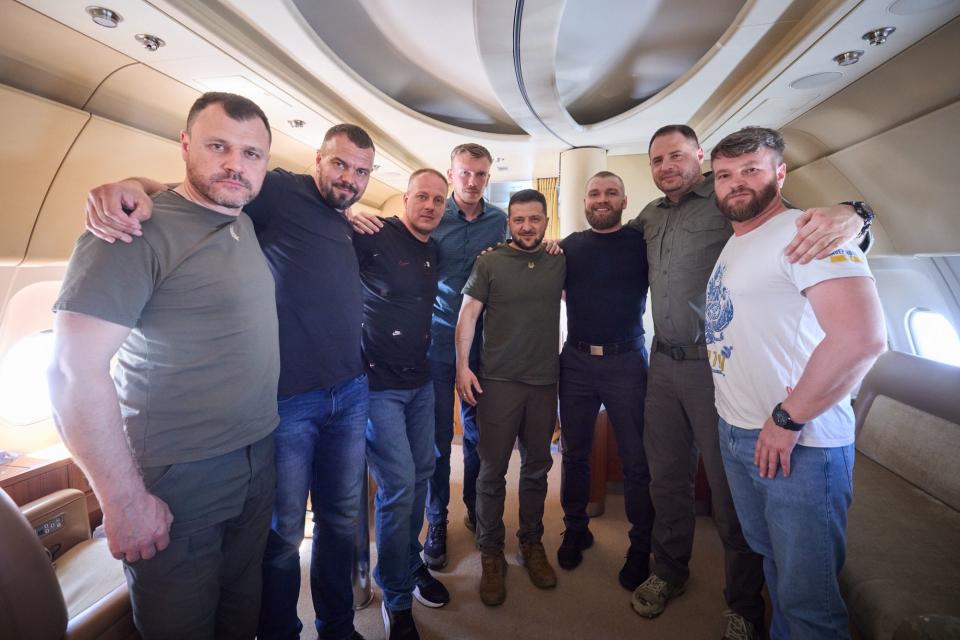
President Volodymyr Zelensky and the commanding officers who defended the Azovstal plant stand in a plane on July 8 before returning to Ukraine (Zelensky's Facebook page).
July 17, 2023:
Russia exits the Black Sea
Grain Initiative
Russia pulled out of the Black Sea Grain Initiative, effectively collapsing the deal. The agreement, brokered by Turkey and the UN in July 2022, played a crucial role in mitigating a global surge in food prices partially caused by Russia's full-scale invasion of Ukraine by allowing Kyiv to export its agricultural products via the Black Sea despite the ongoing invasion. Immediately after the collapse of the deal, Russia started targeted attacks on ports in southern Ukraine.

A vessel is seen in the port upon arriving under the Black Sea Grain Initiative to Odesa, southern Ukraine, April 12, 2023. (Yulii Zozulia/Ukrinform/Future Publishing via Getty Images)
Read more: What’s up with the ‘grain deal’ and Russia?
Oct. 5, 2023:
Hroza missile attack
Russia launched a missile strike against the village of Hroza in Kharkiv Oblast, killing 59 people in what was the deadliest attacks on civilians since the start of the full-scale invasion. Those killed had gathered in a cafe to commemorate fallen soldier Andriy Kozyr when a Russian Iskander-M ballistic missile smashed into the building full of civilians. The attack killed approximately half of the village's population.

In an aerial view, first responders clear rubble at a destroyed shop and cafe after a Russian missile strike in Hroza, Kharkiv Oblast on Oct. 6, 2023. (Yan Dobronosov/Global Images Ukraine via Getty Images)
November 2023:
Failed counteroffensive with
victories in Black Sea
In early June 2023, the Ukrainian military launched its long-awaited counteroffensive aimed at pushing toward the Sea of Azov to cut Russia's land corridor to Crimea. Failing to reach its goals, it was limited to the liberation of a few villages in Zaporizhzhia and Donetsk oblasts, significantly slowed down by Russian minefields and a lack of air superiority and equipment. Ukraine did carry out a series of surprising operations in occupied Crimea and destroyed a number of Russian Black Sea Fleet’s vessels.

A still from a video Ukraine's Military Intelligence (HUR) produced about the operation to regain control of the 'Boyko Towers' oil drilling platforms, published online on Sept. 11, 2023. (Ukraine's Military Intelligence / Facebook)
Read more: Uncertain Triumph: Ukraine picks apart Russia's best air defenses in Crimea
Feb. 8, 2024:
Zelensky dismisses
Commander-in-Chief Zaluzhnyi
President Volodymyr Zelensky dismissed Commander-in-Chief Valerii Zaluzhnyi on Feb. 8, 2024 following months of speculation about a rift between the two. The general, who had led the country's army since July 2021, was replaced by Commander of the Ukrainian Land Forces Oleksandr Syrskyi as part of a broader military leadership reshuffle.
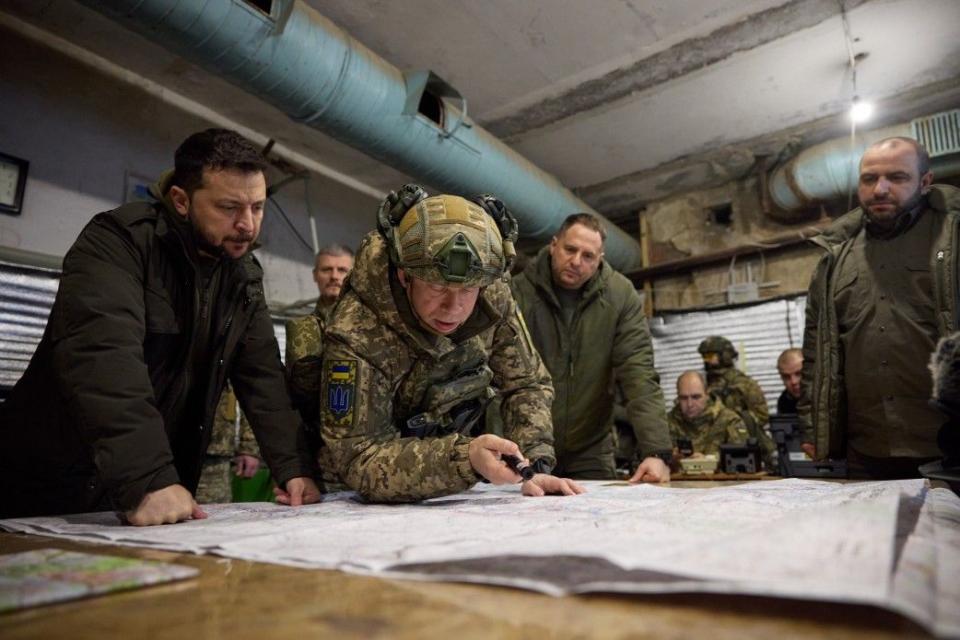
President Volodymyr Zelensky, Defense Minister Rustem Umerov, and Ground Forces Commander Oleksandr Syrskyi during a meeting at a military command post in Kupiansk, Kharkiv Oblast, on Nov. 30, 2023. (President's Office)
Read more: Who is General Syrskyi, Ukraine's new chief commander?
Feb. 18, 2024:
Ukraine withdraws
from Avdiivka
Ukrainian soldiers retreated from Avdiivka on Feb. 18 after months of fierce fighting resumed in October 2023. The city, located north of Russian-occupied Donetsk in eastern Ukraine, had been a Ukrainian stronghold for 10 years and a target of Russia’s since 2014. Ukraine’s Commander-in-Chief Oleksandr Syrskyi said that the decision to withdraw was made to avoid encirclement and to preserve the lives of fighters, however, some of them were captured by Russian troops during the withdrawal.

Ukrainian soldiers on an armored infantry vehicle on the road to Avdiivka, Feb. 14, 2024. (Vlada Liberova/Libkos/Getty Images)
Read more: Russia takes Avdiivka at steep price, as Ukraine forced to face shortcomings
We’ve been working hard to bring you independent, locally-sourced news from Ukraine. Consider supporting the Kyiv Independent.

